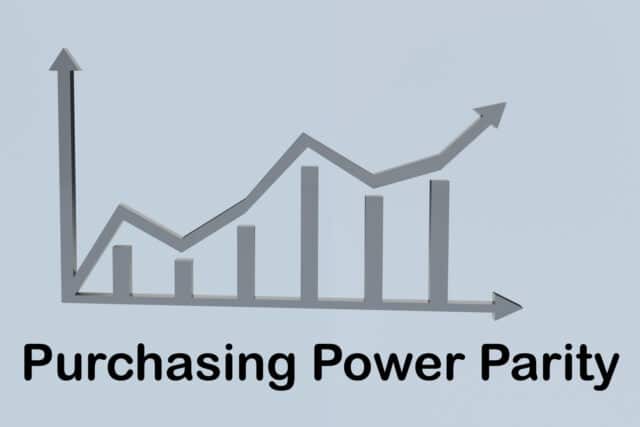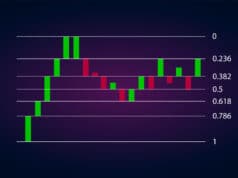PPP was established following World War I. The majority of countries used the gold standard prior to the war. The value of a country’s currency was determined by the gold exchange rate. In order to fund the war, most governments abandoned the gold standard in favor of printing money. As you can expect, this resulted in inflation.
When the war ended, Gustav Cassel, a Swedish economist, advocated that currencies be valued by multiplying their value by the inflation rate. As a result, he laid the groundwork for today’s PPP.
What is PPP?
PPP states that fx rates between legal tenders are in balance when their buying power is equal in both nations. This means that the exchange rate between two nations should be equal to the price level of a defined basket of goods and services in both countries. A country’s domestic prices rise, i.e., when inflation occurs, and the country’s exchange rate must decline in order to revert to PPP.
The “law of one price” is the foundation of PPP. When prices are represented in the same currency, and there are no transportation or other transaction expenses, competitive marketplaces will equalize the price of an identical item in the two nations.
Example
If a guitar costs 350 ZAR in South Africa, it should cost 22.06 USD in the United States if the currency rate between the two countries is 0.063 ZARUSD. Consumers in the United States will choose to buy a TV set in South Africa if the guitar costs just 300 ZAR.
If this procedure (known as “arbitrage”) is carried out on a big scale, US customers purchasing SA items will bid up the value of the ZAR, making SA goods more expensive for them. This procedure continues until the items’ prices are equal once more.
Which are the two concepts used in PPP?
Absolute purchasing power parity (APPP)
This is the basic concept of PPP. The idea holds that a basket of products should have the same value once two currencies have been exchanged. The hypothesis is usually based on the conversion of other international currencies into US dollars.
Example
If the iPhone 13 pro costs $1,099 in Miami, APPP estimates that it will cost $1,099 in Brussels once the USD has been translated to EUR.
If this is not the case, APPP indicates that the legal tender’s fx rate will fluctuate over time until the items are of similar value – since there should be an equilibrium in the price of goods in the absence of trade barriers. This is a price-level theory that exclusively considers the same basket of items in each nation, with no other considerations.
Relative purchasing power parity (RPPP)
RPPP is an extension of APPP, and it will be used in conjunction. RPPP argues that there is a link between price inflation and currency exchange rates, despite the fact that it maintains that the value of the same commodity in various nations should equalize with time. It considers how much of an item or service one unit of money can purchase, which might fluctuate over time as inflation rates vary. According to the principle, inflation reduces a currency’s actual buying power. Hence inflation must be considered when adjusting the PPP.
Example
If China’s inflation rate is 2.42 and the United States is 6.8, the US dollar will depreciate by 4.38 per year against the yuan.
This theory is supported by empirical evidence, particularly when inflation differences are significant.
Formula for calculation
The PPP exchange rate is calculated using the ratio of the two nations’ price levels in APPP. RPPP, on the other hand, is based on the ratio of price changes in the two nations.

How is PPP used?
Economically, PPP measurements are used to compare economic productivity and living standards between nations, and it is most typically used to modify GDP. For example, if market exchange rates were utilized to convert GDP, India would be ranked ninth or tenth in terms of global GDP share. It is rated third when PPPs are used instead, which is a more accurate reflection of its proportion of global GDP.
Individuals and organizations, on the other hand, can use PPP to analyze socioeconomic data in a variety of ways. For example, when assessing carbon emissions, monitoring global poverty, and predicting financial markets. For example, nominal GDP would indicate that the United States is the top carbon emitter. However, PPP is consistent with carbon statistics, indicating that China is the largest source. This is because the PPP is seen to reflect a country’s industrial production better.
PPP data is also frequently used to determine global poverty levels. Analysts utilize global PPP data to examine how shifting price levels affect the number of people living in poverty and to recalculate worldwide projections of when poverty will cease. The PPP-adjusted poverty line was established at $1.90 per day in 2011, implying that anyone earning less than this is regarded to be living in extreme poverty across the world.
Purchasing power parity is also commonly used to detect government market manipulation. Although rare, governments have in the past manipulated inflation numbers in order to portray a healthy economy and raise the currency’s value.
Limitations of PPP
- Transportation expenses, trade obstacles, and other transaction costs can all add up quickly.
- Both nations must have competitive marketplaces for products and services.
- The one-price rule only applies to tradeable items; immovable goods, such as houses, and many locally provided services, are not sold across nations.
- The re-adjustment of prices across multiple marketplaces is generally delayed by multinational firms.
- For services and other non-tradable items, PPP analysis may not be applicable.
Conclusion
Purchasing power parity is a metric for assessing a country’s economic health. PPP is divided into two concepts, each of which is computed differently, despite the fact that it is difficult to calculate since it considers so many factors such as inflation and transportation costs. PPP can assist investors in making well-informed judgments while investing in various nations.




